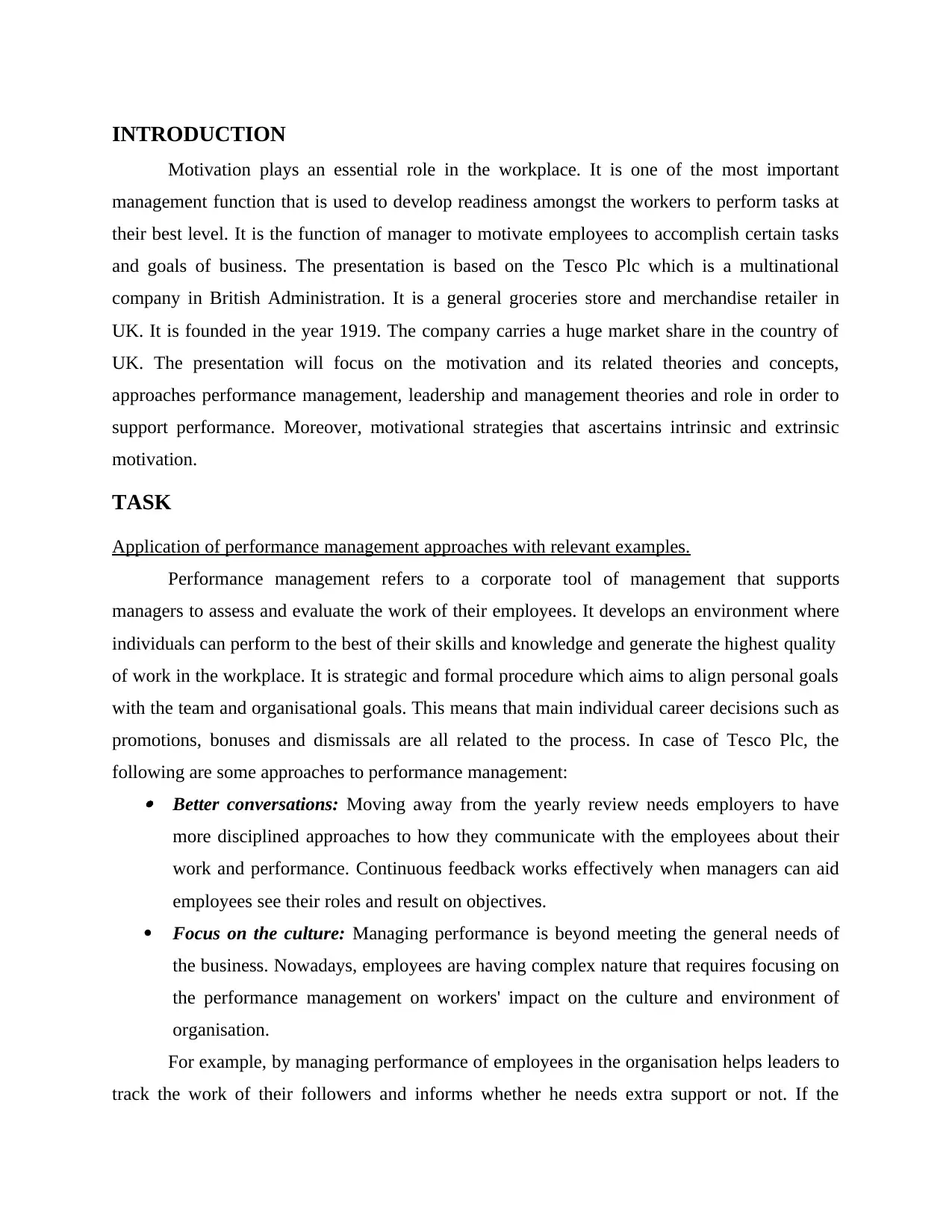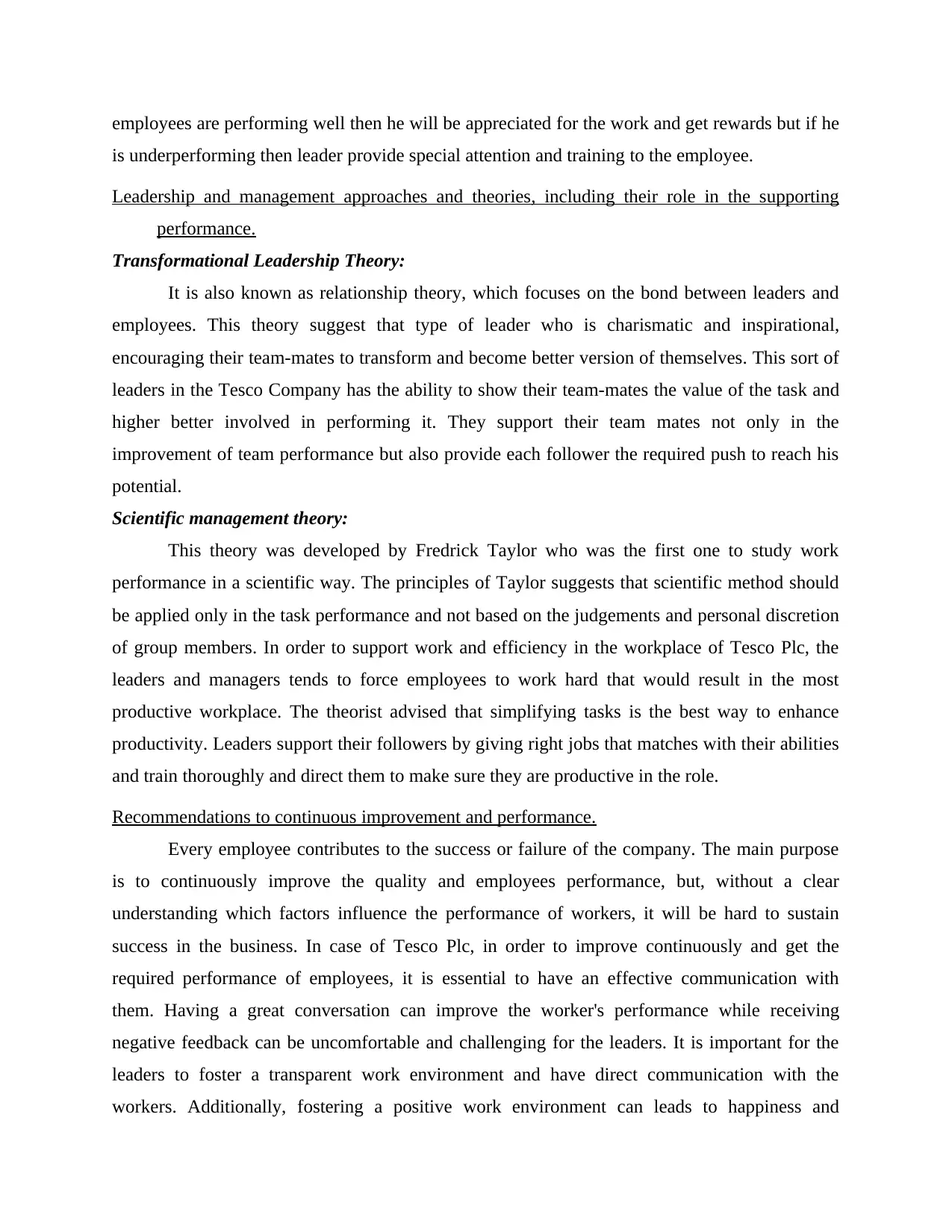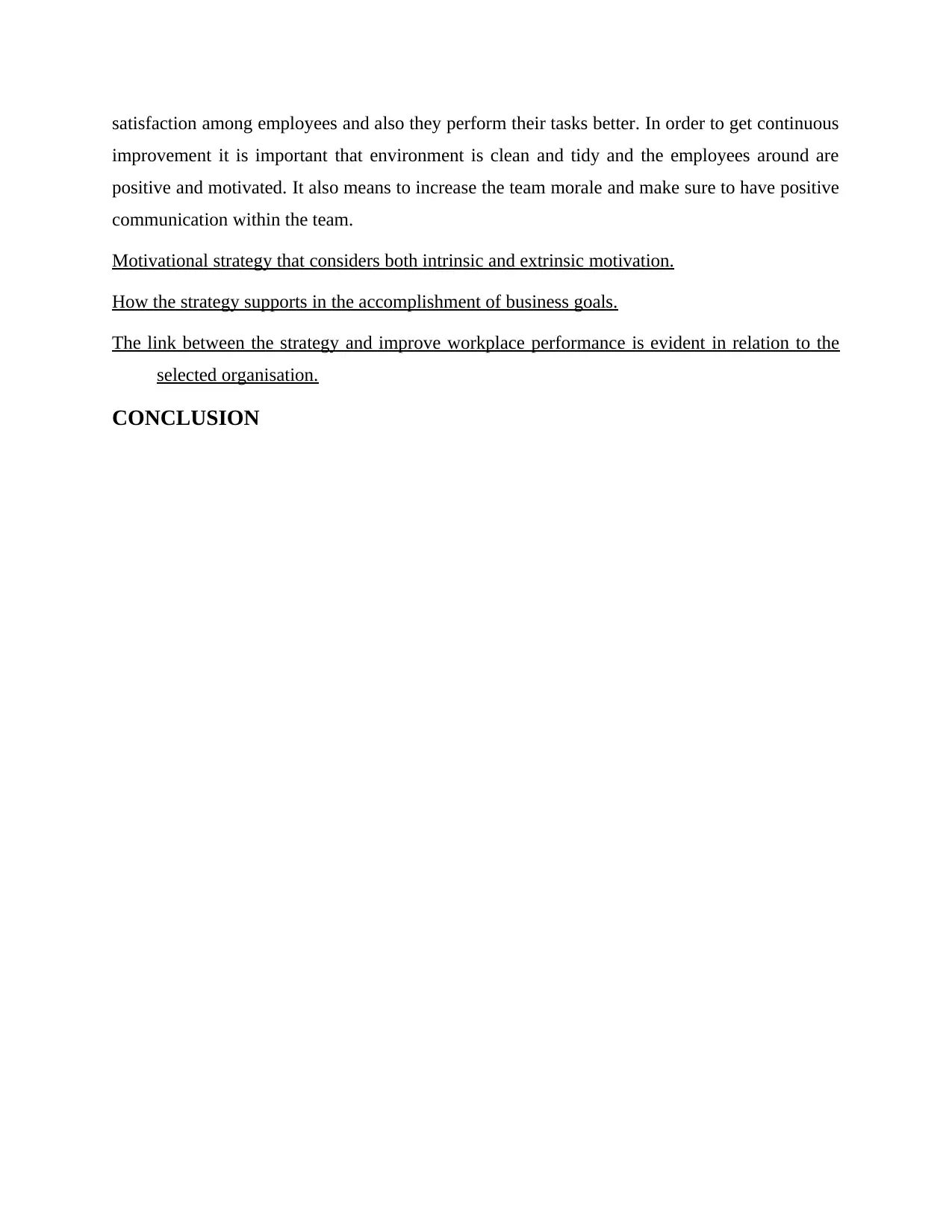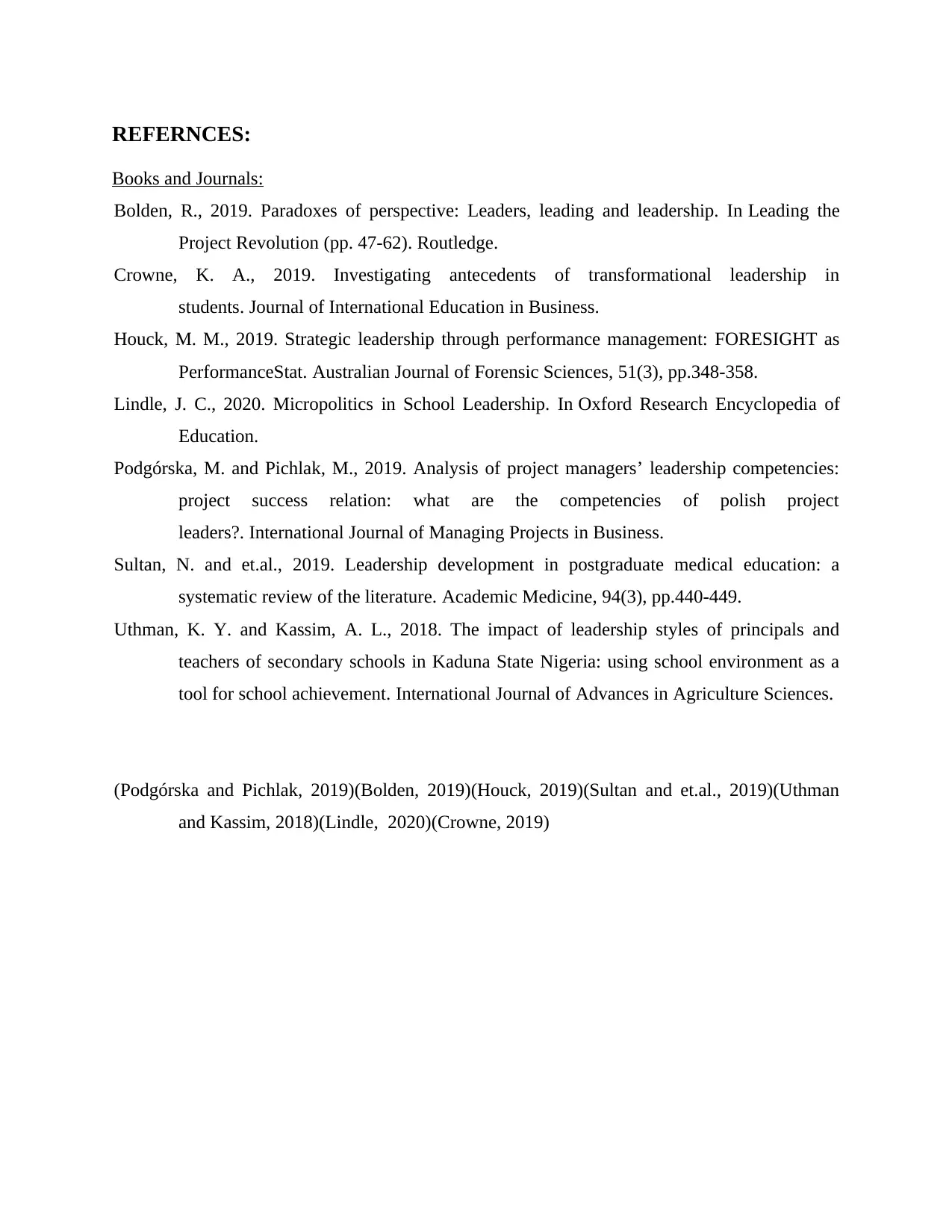Performance Management, Leadership, and Motivation at Tesco Plc
VerifiedAdded on 2023/06/15
|5
|1166
|399
Report
AI Summary
This report presents an analysis of motivational strategies and performance management approaches within Tesco Plc, a multinational British grocery and merchandise retailer. It explores the application of performance management, emphasizing continuous feedback and cultural focus. Various leadership and management theories, including transformational leadership and scientific management, are examined for their role in supporting employee performance. Recommendations for continuous improvement highlight the importance of effective communication and a positive work environment. The report also discusses motivational strategies that consider both intrinsic and extrinsic motivation and their alignment with business goals, demonstrating the link between these strategies and improved workplace performance at Tesco Plc.

Part-2 Presenting
Motivational Stratgey
Motivational Stratgey
Paraphrase This Document
Need a fresh take? Get an instant paraphrase of this document with our AI Paraphraser

INTRODUCTION
Motivation plays an essential role in the workplace. It is one of the most important
management function that is used to develop readiness amongst the workers to perform tasks at
their best level. It is the function of manager to motivate employees to accomplish certain tasks
and goals of business. The presentation is based on the Tesco Plc which is a multinational
company in British Administration. It is a general groceries store and merchandise retailer in
UK. It is founded in the year 1919. The company carries a huge market share in the country of
UK. The presentation will focus on the motivation and its related theories and concepts,
approaches performance management, leadership and management theories and role in order to
support performance. Moreover, motivational strategies that ascertains intrinsic and extrinsic
motivation.
TASK
Application of performance management approaches with relevant examples.
Performance management refers to a corporate tool of management that supports
managers to assess and evaluate the work of their employees. It develops an environment where
individuals can perform to the best of their skills and knowledge and generate the highest quality
of work in the workplace. It is strategic and formal procedure which aims to align personal goals
with the team and organisational goals. This means that main individual career decisions such as
promotions, bonuses and dismissals are all related to the process. In case of Tesco Plc, the
following are some approaches to performance management: Better conversations: Moving away from the yearly review needs employers to have
more disciplined approaches to how they communicate with the employees about their
work and performance. Continuous feedback works effectively when managers can aid
employees see their roles and result on objectives.
Focus on the culture: Managing performance is beyond meeting the general needs of
the business. Nowadays, employees are having complex nature that requires focusing on
the performance management on workers' impact on the culture and environment of
organisation.
For example, by managing performance of employees in the organisation helps leaders to
track the work of their followers and informs whether he needs extra support or not. If the
Motivation plays an essential role in the workplace. It is one of the most important
management function that is used to develop readiness amongst the workers to perform tasks at
their best level. It is the function of manager to motivate employees to accomplish certain tasks
and goals of business. The presentation is based on the Tesco Plc which is a multinational
company in British Administration. It is a general groceries store and merchandise retailer in
UK. It is founded in the year 1919. The company carries a huge market share in the country of
UK. The presentation will focus on the motivation and its related theories and concepts,
approaches performance management, leadership and management theories and role in order to
support performance. Moreover, motivational strategies that ascertains intrinsic and extrinsic
motivation.
TASK
Application of performance management approaches with relevant examples.
Performance management refers to a corporate tool of management that supports
managers to assess and evaluate the work of their employees. It develops an environment where
individuals can perform to the best of their skills and knowledge and generate the highest quality
of work in the workplace. It is strategic and formal procedure which aims to align personal goals
with the team and organisational goals. This means that main individual career decisions such as
promotions, bonuses and dismissals are all related to the process. In case of Tesco Plc, the
following are some approaches to performance management: Better conversations: Moving away from the yearly review needs employers to have
more disciplined approaches to how they communicate with the employees about their
work and performance. Continuous feedback works effectively when managers can aid
employees see their roles and result on objectives.
Focus on the culture: Managing performance is beyond meeting the general needs of
the business. Nowadays, employees are having complex nature that requires focusing on
the performance management on workers' impact on the culture and environment of
organisation.
For example, by managing performance of employees in the organisation helps leaders to
track the work of their followers and informs whether he needs extra support or not. If the

employees are performing well then he will be appreciated for the work and get rewards but if he
is underperforming then leader provide special attention and training to the employee.
Leadership and management approaches and theories, including their role in the supporting
performance.
Transformational Leadership Theory:
It is also known as relationship theory, which focuses on the bond between leaders and
employees. This theory suggest that type of leader who is charismatic and inspirational,
encouraging their team-mates to transform and become better version of themselves. This sort of
leaders in the Tesco Company has the ability to show their team-mates the value of the task and
higher better involved in performing it. They support their team mates not only in the
improvement of team performance but also provide each follower the required push to reach his
potential.
Scientific management theory:
This theory was developed by Fredrick Taylor who was the first one to study work
performance in a scientific way. The principles of Taylor suggests that scientific method should
be applied only in the task performance and not based on the judgements and personal discretion
of group members. In order to support work and efficiency in the workplace of Tesco Plc, the
leaders and managers tends to force employees to work hard that would result in the most
productive workplace. The theorist advised that simplifying tasks is the best way to enhance
productivity. Leaders support their followers by giving right jobs that matches with their abilities
and train thoroughly and direct them to make sure they are productive in the role.
Recommendations to continuous improvement and performance.
Every employee contributes to the success or failure of the company. The main purpose
is to continuously improve the quality and employees performance, but, without a clear
understanding which factors influence the performance of workers, it will be hard to sustain
success in the business. In case of Tesco Plc, in order to improve continuously and get the
required performance of employees, it is essential to have an effective communication with
them. Having a great conversation can improve the worker's performance while receiving
negative feedback can be uncomfortable and challenging for the leaders. It is important for the
leaders to foster a transparent work environment and have direct communication with the
workers. Additionally, fostering a positive work environment can leads to happiness and
is underperforming then leader provide special attention and training to the employee.
Leadership and management approaches and theories, including their role in the supporting
performance.
Transformational Leadership Theory:
It is also known as relationship theory, which focuses on the bond between leaders and
employees. This theory suggest that type of leader who is charismatic and inspirational,
encouraging their team-mates to transform and become better version of themselves. This sort of
leaders in the Tesco Company has the ability to show their team-mates the value of the task and
higher better involved in performing it. They support their team mates not only in the
improvement of team performance but also provide each follower the required push to reach his
potential.
Scientific management theory:
This theory was developed by Fredrick Taylor who was the first one to study work
performance in a scientific way. The principles of Taylor suggests that scientific method should
be applied only in the task performance and not based on the judgements and personal discretion
of group members. In order to support work and efficiency in the workplace of Tesco Plc, the
leaders and managers tends to force employees to work hard that would result in the most
productive workplace. The theorist advised that simplifying tasks is the best way to enhance
productivity. Leaders support their followers by giving right jobs that matches with their abilities
and train thoroughly and direct them to make sure they are productive in the role.
Recommendations to continuous improvement and performance.
Every employee contributes to the success or failure of the company. The main purpose
is to continuously improve the quality and employees performance, but, without a clear
understanding which factors influence the performance of workers, it will be hard to sustain
success in the business. In case of Tesco Plc, in order to improve continuously and get the
required performance of employees, it is essential to have an effective communication with
them. Having a great conversation can improve the worker's performance while receiving
negative feedback can be uncomfortable and challenging for the leaders. It is important for the
leaders to foster a transparent work environment and have direct communication with the
workers. Additionally, fostering a positive work environment can leads to happiness and
⊘ This is a preview!⊘
Do you want full access?
Subscribe today to unlock all pages.

Trusted by 1+ million students worldwide

satisfaction among employees and also they perform their tasks better. In order to get continuous
improvement it is important that environment is clean and tidy and the employees around are
positive and motivated. It also means to increase the team morale and make sure to have positive
communication within the team.
Motivational strategy that considers both intrinsic and extrinsic motivation.
How the strategy supports in the accomplishment of business goals.
The link between the strategy and improve workplace performance is evident in relation to the
selected organisation.
CONCLUSION
improvement it is important that environment is clean and tidy and the employees around are
positive and motivated. It also means to increase the team morale and make sure to have positive
communication within the team.
Motivational strategy that considers both intrinsic and extrinsic motivation.
How the strategy supports in the accomplishment of business goals.
The link between the strategy and improve workplace performance is evident in relation to the
selected organisation.
CONCLUSION
Paraphrase This Document
Need a fresh take? Get an instant paraphrase of this document with our AI Paraphraser

REFERNCES:
Books and Journals:
Bolden, R., 2019. Paradoxes of perspective: Leaders, leading and leadership. In Leading the
Project Revolution (pp. 47-62). Routledge.
Crowne, K. A., 2019. Investigating antecedents of transformational leadership in
students. Journal of International Education in Business.
Houck, M. M., 2019. Strategic leadership through performance management: FORESIGHT as
PerformanceStat. Australian Journal of Forensic Sciences, 51(3), pp.348-358.
Lindle, J. C., 2020. Micropolitics in School Leadership. In Oxford Research Encyclopedia of
Education.
Podgórska, M. and Pichlak, M., 2019. Analysis of project managers’ leadership competencies:
project success relation: what are the competencies of polish project
leaders?. International Journal of Managing Projects in Business.
Sultan, N. and et.al., 2019. Leadership development in postgraduate medical education: a
systematic review of the literature. Academic Medicine, 94(3), pp.440-449.
Uthman, K. Y. and Kassim, A. L., 2018. The impact of leadership styles of principals and
teachers of secondary schools in Kaduna State Nigeria: using school environment as a
tool for school achievement. International Journal of Advances in Agriculture Sciences.
(Podgórska and Pichlak, 2019)(Bolden, 2019)(Houck, 2019)(Sultan and et.al., 2019)(Uthman
and Kassim, 2018)(Lindle, 2020)(Crowne, 2019)
Books and Journals:
Bolden, R., 2019. Paradoxes of perspective: Leaders, leading and leadership. In Leading the
Project Revolution (pp. 47-62). Routledge.
Crowne, K. A., 2019. Investigating antecedents of transformational leadership in
students. Journal of International Education in Business.
Houck, M. M., 2019. Strategic leadership through performance management: FORESIGHT as
PerformanceStat. Australian Journal of Forensic Sciences, 51(3), pp.348-358.
Lindle, J. C., 2020. Micropolitics in School Leadership. In Oxford Research Encyclopedia of
Education.
Podgórska, M. and Pichlak, M., 2019. Analysis of project managers’ leadership competencies:
project success relation: what are the competencies of polish project
leaders?. International Journal of Managing Projects in Business.
Sultan, N. and et.al., 2019. Leadership development in postgraduate medical education: a
systematic review of the literature. Academic Medicine, 94(3), pp.440-449.
Uthman, K. Y. and Kassim, A. L., 2018. The impact of leadership styles of principals and
teachers of secondary schools in Kaduna State Nigeria: using school environment as a
tool for school achievement. International Journal of Advances in Agriculture Sciences.
(Podgórska and Pichlak, 2019)(Bolden, 2019)(Houck, 2019)(Sultan and et.al., 2019)(Uthman
and Kassim, 2018)(Lindle, 2020)(Crowne, 2019)
1 out of 5
Related Documents
Your All-in-One AI-Powered Toolkit for Academic Success.
+13062052269
info@desklib.com
Available 24*7 on WhatsApp / Email
![[object Object]](/_next/static/media/star-bottom.7253800d.svg)
Unlock your academic potential
Copyright © 2020–2025 A2Z Services. All Rights Reserved. Developed and managed by ZUCOL.




